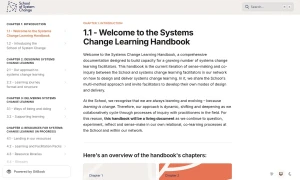Calin emphasises the critical importance of establishing a learning culture within organisations, looking at barriers and a need to shift perspective in order to take the next steps forward. This thought piece is an output of the MEL in Systems Change Inquiry Group, hosted by the School of System Change in 2023.
Organizations endeavoring to create systems change face a complex and ever-evolving landscape that requires a great deal of agility and flexibility to navigate – a fact that I’m all too familiar with working in an organization with dozens of multi-stakeholder initiatives striving to contribute towards systems change. To manage this complexity effectively, it’s critical to embrace a learning culture that can support agility. Monitoring, evaluation and learning (MEL), in theory, is meant to play a critical role in supporting agile project management and decision making, however the important role that MEL plays in systems work goes deeper than that.
MEL, as a means to learn and adapt, and its involvement of many people in those processes – if done right – has the potential to provide core benefits that could contribute to better and more equitable processes when it comes to systems change work. These core benefits include the activities and participatory tools that allow unique and varied perspectives to surface, that challenge assumptions, and that shift understandings of the context of a project, and relevant problems and solutions. Where the objective in much of the systems change work happening today is about shifting mental models and changing power dynamics within relationship structures, in some ways, MEL can provide an immediate example within systems change work of what it means to make space for surfacing new understandings and inclusive and decision-making processes.
The Challenge of Building a Learning Culture
The effective implementation of MEL in systems change projects hinges on the establishment of a learning culture within organizations. Having a learning culture within an organization means that it values continuous learning, and enables individual and collective growth and adaptability. This culture is fostered through an emphasis on collecting and reflecting on feedback, spaces that allow for open communication and questioning of assumptions underpinning an organization’s activities, and an appreciation of risk taking and learning from failures.
However, as I am not the first to lament: it is all too common that the reality is that there is limited time, willingness or incentives for teams to reflect on feedback and results, or even question why they are doing certain activities, squelching opportunities for exploration, innovation and adaptability. In practice, many organizations do not embrace acknowledging failure, reducing the desire for employees to take risks or be vulnerable about mistakes. Moreover, the intangibility of the results of “doing” learning makes it harder to immediately see its value, and it is more likely sidelined within organizations where there is a need for quick turnaround times and quick wins. Consequently, the organization becomes mired in the status quo, unable to foster the internal adaptations necessary for effective systems change.
As a member of a MEL in Systems Change Inquiry Group over the last months, I embarked on a journey to explore how organizations can establish a learning culture that enables MEL to enhance systems change work. And perhaps in the spirit of systems change, where the very essence lies in questioning assumptions and embracing new and adaptive practices, my own journey with this group has been unexpectedly eye-opening in challenging my own preconceptions about my approaches as a MEL practitioner.
A Shift in Perspective
In my pursuit of fostering a culture of learning within my organization, a significant portion of my focus to date has been on creating operational procedures that can facilitate feedback loops and learning (for instance setting minimum requirements around submitting final evaluations and learning reports). In doing this, I have been trying to create more control around how colleagues accumulate shared knowledge and learn.
It has been through my interactions with the Inquiry Group, however, that has led to question some of my current ways of thinking and approaches as a MEL practitioner, as I realize that I have been vastly underestimating the importance of actively involving the people who both own and benefit from the knowledge we seek to cultivate. This realization has reshaped my approach to my current role, spurring me to look into how I can put a new plan in place that goes beyond what I’m currently doing in ways that can both engage a broader audience and place others in the driving seat when it comes to strengthening their collective learning.
Together as a group, we discussed the necessity for:
Embracing Natural Learning: One insightful perspective that emerged from these discussions is the concept of embracing natural learning processes. Rather than imposing rigid, pre-defined learning procedures, it was suggested that we start by understanding the organic and informal ways in which learning, or sharing of information and insights, already takes place.
Although these processes may not align with the structured frameworks some prefer (and that I’ve been trying to build within my organization), it is imperative to recognize and harness these inherent pockets of learning to bolster our broader objectives, especially in the context of systems change work. This approach holds dual benefits. Firstly, it aligns with the path of least resistance, as it taps into learning that is already naturally occurring. The other is that there are knowledge that may not easily surface through a set of official questions or standardized report templates – because quite frankly we don’t always know the right questions to ask – so leveraging natural learning processes opens the door to tapping into this tacit knowledge and enriching our understanding of the intricacies involved.
Piloting Collaborative Learning Initiatives: A key component of the transformation towards a learning organization involves empowering individual teams to actively engage in learning initiatives. By piloting exercises that place teams in the driver’s seat of figuring out how to unearth and explore their learnings, we can encourage them to collaboratively explore core project hypotheses and critical assumptions. This approach allows for a dynamic process of exploration and sense-making, particularly in light of the ever-changing realities in systems. It places the teams at the heart of decision-making, facilitating a deeper understanding of what needs to change in response to new insights and circumstances.
Building Ownership and Appreciation: The transformation of an organization's learning culture is a collaborative effort that transcends any specific organizational function and the contributions of a single individual. It necessitates the buy-in and support of a diverse group of stakeholders from various functions and sectors.
Building a learning culture is akin to the collective nature of systems change work, requiring the involvement of champions and advocates throughout the organization, and transcending traditional boundaries as well as integrating differing perspectives and opinions. Critical functions such as human resources play a pivotal role in creating incentives for tracking progress and nurturing a culture of learning.
The Path Forward: Practical Steps
Based on the insights gained from the Inquiry Group, here are three immediate steps to strengthen an organization’s culture of learning – all areas that I aim to ponder more about in the coming months and think about how to mold into my work:
1. Unearth the learning that’s currently happening. Identify and leverage the informal learning processes already at work within your organization.
For instance, one of our Inquiry Group members - Jewlya - has explored, through the creation of a framework that includes conducting systems sensing and contribution stories, how learnings can be naturally discovered and move us from the cycle of simply reaffirming information that we already think to be true.
2. Collaborate on pilots with teams: Begin by taking small steps, such as initiating small-scale learning pilots with individual teams, focusing on exploring project hypothesis or conducting Action Reviews. Promote the benefits of these exercises widely.
3. Create spaces for transparency: Foster spaces that allow for transparency and vulnerability, ensuring that at the same time these opportunities address power differentials, territoriality, and the fear of failure.
Establishing a learning culture within organizations is not merely a desirable goal; it is an imperative for thriving in the complex world of systems change. It’s a journey that values learning, experimentation and collective growth, placing people at the forefront of this endeavor. In doing so, only then can we better adapt to change and thrive in an ever-evolving landscape.






